POULTRY FENCES
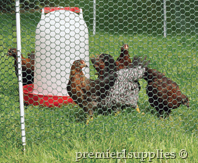
NoShock Chick Fence has 3/4" openings and can be used to make a daytime outside pen for chicks. After chicks grow larger, change to electrified PoultryNet™, which provides predator protection.
Why NoShock Chick Fence?
Because chicks and ducklings are too small to be contained by PoultryNet. They can slip through the 2"x 3" openings at the bottom of PoultryNet. And they weigh too little to make an electrical connection and be deterred by the net.
That’s why we now offer a nonelectrifiable alternative to PoultryNet with “chick-stop” openings to keep in chicks, ducklings and other small birds.
Can also be used to keep free-range birds out of flowerbeds and gardens and away from patios and roadways.
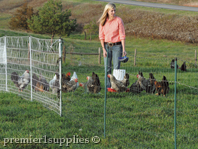
Above is our PoultryNet™ Plus 12/48/3 green and black/white. Which to choose? Choose green net if you would like the fence to blend in to the background. Choose black/white if you want a highly visible fence.
Once your chicks have outgrown their NoShock enclosure, it's time to think about giving them larger roaming room with poultry netting.
What is poultry netting?
An electrifiable, prefabricated, portable fence. Arrives as a complete fence (except for an energizer and lightweight corner posts) with line posts built into each roll. We use it extensively on our farms for managing our poultry.
Fencing an area with multiple curves and corners?
Consider using PoultryNet™ Plus and PermaNet® Plus nets. The added posts provide increased support and help reduce potential sagging.
Remember to electrify with our energizer kits.
PREMIER SOLAR ENERGIZERS
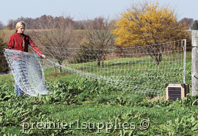
A roll of PoultryNet™ energized by a PRS Solar Energizer is a popular combination for folks building fence for their poultry.
Which unit is right for you?
The size, in pulse energy output (range from .5 joule to 2 joules), depends almost entirely on the weed contact that will occur and the length of the fence.
Contact Premier or call 800-282-6631 to speak with one of our fence consultants to help you determine the best energizer for your needs.
You can also view our energizer comparison charts online or in Premier's fencing catalog for help in choosing an energizer.
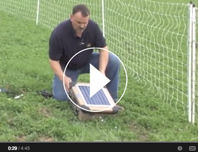
Fencing season is here. You'll find our video above on "How to get your PRS Solar Energizer ready for fencing season" helpful, with instructions and tips the folks at Premier have learned by experience.
|
 |
 |
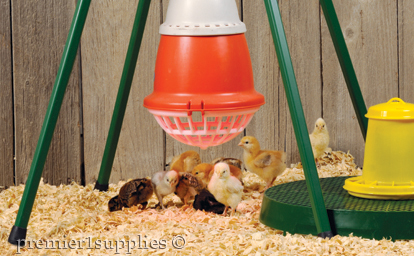
Brooders need to be a safe haven for chicks to protect them from cold drafts and predators.
Spring chicks are just
around the corner
In a few weeks many of you will be making a mad-dash across a windswept driveway from your car to the poultry house. Why? First, there are few things draftier than a February morning outdoors. Secondly, a box of baby chicks arrives at the post office with the phrase "Keep out of drafts" prominently labeled in bold letters.
But once you've run the gauntlet and have brought your young birds into the poultry house, it's time to get them started on the right track. To do this, you need a brooder. In his article below, Harvey Ussery discusses both artificial and natural brooding (having a hen to raise her own chicks).
If you're making the mad-dash from the post office or the farmstore with your new chicks, a broody hen is no longer an option. But you'll find the artificial brooder works quite well. Be sure to set it up before bringing home the chicks, a warm area with fresh water and chick feed in place.
BROODING CHICKS: TWO OPTIONS
Starting Chicks in a Brooder
Chicks in the mail
It surprises many would-be keepers of poultry that just-hatched chicks can be sent through the mail. But an interesting fact of chick embryology is that, just before a hatching chick breaks out of its shell, it absorbs and stores the last of the yolk. It now has water and food reserves that support it while it waits—for two or even three days if necessary—for its slower siblings to hatch. This provision by nature to sustain the new hatchling while waiting for its first drink or first meal is the key to shipping day-old chicks from a hatchery far away to your front door.
There are many hatcheries to order from, from massive operations like Murray McMurray; to small regional, family-owned hatcheries; to individual breeders you can get in touch with by joining preservation organizations like Society for the Preservation of Poultry Antiquities and American Livestock Breeds Conservancy. (See insert, “Help Finding Best Breeds,” at the bottom of this page.) Success with purchased chicks is relatively easy, so long as you remember that they rely on you to fulfill their every need. Don’t forget for a minute: You are Mama!
Setting up the brooder
Be sure to have your brooder set up and ready before the chicks arrive. You can of course buy a commercial brooder, complete with heat lamps, feeder trays, and waterers. It is cheap and easy, however, to assemble the brooder using whatever materials are at hand. For a small group of chicks, you might even use a large cardboard box, maybe the carton an appliance was shipped in. I make an ersatz brooder with four large pieces of scrap plywood, assembled in a box shape with four screws when needed, and hung flat on a wall when not.
Some folks prefer a brooder without corners (where chicks might in some conditions “pile up” and suffocate). In lieu of a cardboard box, they cut a long strip of cardboard maybe two feet wide, and set it in place as a circular enclosure. Another option is a “hover”: A box-like structure of metal or plywood, containing the heat lamps or other heat source, is suspended a few inches over the brooder floor, allowing the chicks to retreat under the hover to warm up, or to range in the cooler areas outside the hover. If the feed and water are placed outside the perimeter, such an arrangement speeds feathering and “hardening off” of the young birds.
Conditions in the brooder can be judged by the Goldilocks principle: They should be “just right,” avoiding the extremes of too cold or too warm, too drafty or too stuffy.
This article is Copyright by Harvey Ussery and reprinted with permission. Harvey Ussery is the author of The Small Scale Poultry Flock (Chelsea Green, 2011), on sale in Premier's book section. Visit Harvey's website
at www.themodernhomestead.us.
Read More »
EXTENSION NEWS
Small Flock Series: Brooding and Growing Chicks
By Jesse J. Lyons, Department of Animal Sciences.
Copyright 1993 to 2013
University of Missouri. Published by MU Extension, all rights reserved.
To raise a flock of chickens that will suit your needs, whether for eggs, meat or show, start with quality chicks. Obtain chicks from a hatchery that participates in the National Poultry Improvement Program. There are some advantages in buying chicks or fertile eggs from local sources if they can provide quality chicks or eggs as well as information and service to their customers. In general, if you are interested only in egg production, order sexed pullets of Leghorn or other egg-type strains. If you are interested in meat, order one of the popular Cornish broiler crosses or White Plymouth Rocks. Dual-purpose strains are well suited for growers interested in both eggs and meat production. Birds for show and fair competition will require special strain evaluation and appraisal.
Brooding chicks
Poultry housing should provide clean, dry, comfortable quarters for birds throughout the year. To brood chicks, you need adequate heat and space. The house and equipment should be clean and in good repair. Set up and warm the brooding area before the chicks arrive. Chicks will need a warm, draft-free location with proper ventilation and access to clean water, appropriate feed and protection.
Read More »
NEW! POULTRY SOLUTIONS CATALOG
New Poultry Products
Our new catalog has already been in folks' hands for almost a month, but we still want to talk about it! It's 54 pages of useful poultry raising knowledge and products that make poultry production easier. Below are some of this year's new products.
| • |
Ceramic Eggs—New sizes for geese and quail. |
| • |
Egg Skelter—Keep eggs in style on countertop. |
| • |
Egg Stamps & Ink—Mark eggs as your own with stamps or customizable names/logos. |
| • |
EZ CatchNet—Lightweight, strong net, convenient telescoping handle. |
| • |
FiberTuff™ Posts—Support for netting at curves, corners, ends and major directional changes. |
| • |
Heating Plate & Chick Drinker—An alternative to heat lamps for chicks. Nipple drinker sits on plate or hangs to provide always-clean water. |
| • |
HotGate® and Handle Kit—Complete net gate ties onto the end of existing electrified poultry net. Handles allow for easy “shock-free” access into any netting enclosure. |
| • |
NoShock Chick Fence—Allows young poultry to forage outside even when they’re too small for regular electrified netting. |
| • |
Plastic Leg Bands—Identify your birds with small, medium or large prenumbered (1 to 25) plastic leg bands. 3 sizes in 5 colors. |
| • |
Poultry Crate—Large, sturdy transport crate, 2 doors. Collapses for shipping. |
| • |
Poultry Door—Reliable automatic door with daylight sensor opens to let birds out at sunrise, closes to secure the coop at dusk. |
| • |
Vintage Egg Carton—Old-fashioned farm scene on lid of the carton; 3 rows of 4 eggs. |
See our full line of Poultry Products.
|
|